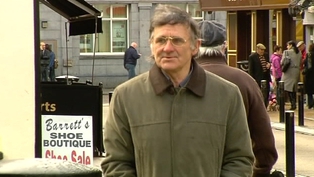Ireland’s Tax revenue returns are up over €1 billion on last year
 Up
Up
TAX REVENUES for the first two months of the year were more than €1.05 billion ahead of the same period last year, figures from the Department of Finance show.
The exchequer returns, published yesterday, put overall tax revenue for the end of February at € 5.9 billion, up nearly 22 per cent on last year.
Significantly, the tax take was also € 656 million or 12.5 per cent ahead of the department’s own expectation. However, the ministry warned there were two specific factors driving this “over performance”.
The large year-on-year increase was partly due to the late payment in January of more than € 250 million in corporation tax which had originally been due in December.
The figures were also boosted by a 32.7 per cent surge in income tax receipts, which came in € 643 million up on last year, reflecting the impact of the universal social charge and the technical reclassification of receipts from employers which they had previously returned as PRSI.
While monthly tax receipts are notoriously volatile, they remain one of the timeliest measures of the health of the economy.
VAT and excise duties – the other of the “big four” tax-heads – performed close to expectations so far this year, coming in marginally up on the same period last year, although VAT receipts were lower than anticipated. This could mean that the two percentage point increase in VAT, introduced in Budget 2012, has depressed consumer spending by more than expected.
The figures showed the increased tax and non-tax revenues were offset by the higher cost of servicing the national debt. The State has spent € 891 million so far this year servicing the interest on its debt, compared with € 626 million by the end of February last year, reflecting the State’s bigger debt burden.
The figures showed overall spending for the month was € 7.5 billion, € 475 million or 6.8 per cent up than the same period last year. Current, or day-to-day, spending by the Government was €7.16 billion in the first two months of the year, up 7.4 per cent on the same period last year. An overspend in the Department of Social Protection, related to income tax/PRSI reclassification, was the main reason.
The exchequer deficit at end of February stood at 2.07 billion, up from €1.94 billion recorded at the same stage last year. The overall exchequer deficit for 2012 is expected to be in the region of €18 billion
Farmer is fined €25,000
For interfering with & demolishing a 1,000 year old ring fort in Kerry

A farmer has been fined €25,000 for destroying a 1,000-year-old ring fort on his land, which was a protected national monument.
John O’Mahony, 64, pleaded guilty to carrying out work on the fort on his farm in north Kerry, without first notifying the National Monuments Service
Mr O’Mahony farms around 40 acres at Clashmealcon, near Causeway.
A ring fort and series of souterrains or underground tunnels – which were said to over 1,000 years ago – were on the lands, and were of historic importance.
Mr O’Mahony hired workers, in February 2008, to demolish the majority of the ring fort.
The Tralee court heard that he knew of the existence of the ring fort as he had previously objected to a planning application there on the grounds that the land contained “an historical ring fort”.
He had only bought the lands two months before.
Mr O’Mahony apologised through his barrister. He said he did not know he had to seek permission for the work.
Judge Carroll Moran said ownership of property is a right, but this right was not “unfettered”.
Good advice is do not interfere with anything associated with Ireland's protected Forts
Women in Ireland earn 17% less than their men counterparts
The European Commission study indicated that only 123,000 women here earn more than €50,000 per year in comparison to 254,000 men. Women are still earning substantially less than men in Ireland despite efforts to promote equality in the workplace.
According to a study by the European Commission, women here earn on average 17.1 per cent less than men.
The study also indicated that only 123,000 women in Ireland earn more than €50,000 per year in comparison to 254,000 men.
The report, published today to coincide with European Equal Pay Day, noted the gender pay gap existed even though women did better at school and university than men.
It found women across the European Union earned on average 17 per cent less per hour than their male counterparts.
However, the pay gap varied significantly between countries from below 10 per cent in Belgium, Italy, Slovenia, Poland to above 20 per cent in Britain, Greece, Germany, Austria and Finland.
The study also suggested that younger women suffered less pay discrimination than their older colleagues.
The report found that Irish women in their 20s earned about 90 per cent of what their male equivalents did.
However, women in the 35-44 age group only earned 71.5 per cent of what male colleagues earned, and this falls even further for women in their 50s and 60s who earned only 61.4 per cent of men in the same age group earned.
The report said there were a number of reasons for the gender pay gap, including the discrimination against women, undervaluing of women’s work and skills and the low number of women in senior and leadership positions.
It also noted the fact that women continued to have the primary responsibility for care in our society which undermined their ability to earn as much as men.
Chief executive of the National Women’s Council of Ireland Orla O’Connor said: “In order to achieve equality for women in Ireland, the gap between women’s and men’s earning needs to be reduced, this means putting place family friendly policies, subsidised childcare provision to address the imbalance of care responsibilities in Ireland and ensuring that women are fully represented in senior positions in all areas of society.
“As the Government persists with its austerity measures it is vital that actions to improve the position of women in our society are not side-lined,” she said
How marijuana affects your brain & makes you forget
Drug affects previously overlooked with brain cells that have a crucial role in the formation of memory .
The drug impairs users’ working memory — the ability to retain and use information over short periods of time. Neuroscientists Giovanni Marsicano of the University of Bordeaux, France, and Xia Zhang of the University of Ottawa Institute of Mental Health Research now show that this common side effect occurs because of a previously unknown signalling mechanism between neurons and non-neuronal cells called astrocytes. Their work is published today in Cell1.
Understanding how marijuana impairs memory could help researchers to create drugs that have the same therapuetic benefits but fewer side effects.
The star-shaped astrocytes have long been considered nothing more than support cells that protect neurons. “Our study provides compelling evidence that astrocytes control neurons and memory,” says Zhang. “The supporting actor has become the leading actor.”
The psychoactive ingredient of marijuana is tetrahydrocannabinol (THC). Using microelectrodes implanted into the brains of anaesthetized rats, the researchers found that the compound weakens the connections, or synapses, between neurons in the hippocampus, a structure that is crucial for memory formation.
They repeated these experiments in two types of mice that had been genetically modified to alter their production of CB1 receptors, the molecules that interact with THC in the brain. One mouse strain lacked CB1 receptors in hippocampal neurons that synthesize the neurotransmitter glutamate; the other lacked them in those that synthesize the neurotransmitter GABA.
A process of elimination
THC weakened the synapses in both types of mouse in the same way as in unmodified strains, so the researchers reasoned that that the effects of THC must be mediated by CB1 receptors on astrocytes. Marsicano therefore created a third type of mouse, which lacked the receptor in astrocytes. He found that THC had no effect on their hippocampal synapses.
Another set of experiments, on synapse preparations in Petri dishes, revealed that activation of astrocyte CB1 receptors by THC caused receptors for a compound called AMPA to be removed from the membranes of neurons. The removal and insertion of AMPA receptors have been found to mediate weakening and strengthening of synapses respectively, but it was not previously known that astrocytes can control these processes.
Finally, the researchers tested the three strains of mutant mice with a working-memory task in which they had to remember the location of a submerged platform in a water maze. THC impaired the performance of mice lacking the CB1 receptor in neurons that synthesize glutamate and GABA, but not those lacking the receptor in astrocytes.
“It’s always difficult to extrapolate from rodents to humans,” says Marsicano, “but marijuana impairs working memory in both species, so I expect that similar mechanisms are involved.”
Cause and effect
Ben Whalley, a pharmacologist at the University of Reading, UK, says that the work demonstrates an exciting causal link between astrocyte signalling and cognitive function. “It’ll be fascinating to investigate their consequences for endogenous cannabinoid signalling in normal brain function and in pathological states,” he adds.
Marsicano says that the findings could eventually lead to THC-related drugs that specifically target CB1receptors expressed by neurons and not astrocytes. Such compounds might have therapeutic effects, for example as painkillers, without affecting the function of working memory.
“But,” cautions Whalley, “we still haven’t separated out the different effects of neuronal and astrocyte CB1receptors, so the jury’s still out on the potential therapeutic effects of targeting the neuronal receptors.”
In the meantime, there may be a far simpler way of minimizing the unwanted side effects of medicinal marijuana.
No comments:
Post a Comment